Section 8. Radar Departures
- Views Views: 1,237
- Last updated Last updated:
-
Sub-pages:
Section 8. Radar Departures
5-8-1. PROCEDURES
- When vectoring a departing aircraft on a radar SID, concurrent use of a diverse vector area (DVA) is not permitted.
- When the departure route description on a radar SID contains the phrase, “Fly assigned heading,” “as assigned by ATC,” or similar phrases, with a published range of headings in the route description, assign headings or vectors as needed not to exceed those headings in the published range until reaching the MVA/MIA.
5-8-2. INITIAL HEADING
-
Before departure, assign the initial heading consistent with either a SID being flown or DVA, if applicable, when
a
departing aircraft is to be vectored immediately after takeoff. At locations that have a DVA, concurrent use of
both a
SID and DVA is not permitted.
- PHRASEOLOGY
- FLY RUNWAY HEADING.
- TURN LEFT/RIGHT, HEADING (degrees).
- NOTE:
- 1. TERMINAL. A purpose for the heading is not necessary, since pilots operating in a radar environment associate assigned headings with vectors to their planned route of flight.
- 2. ATC assumes responsibility for terrain and obstacle avoidance when IFR aircraft are below the minimum IFR altitude (MVA, MIA, MEA) and are taken off departure/ missed approach procedures, or if issued go-around instructions, except after conducting a visual approach. ATC does not assume this responsibility when utilizing a Diverse Vector Area (DVA) or when operating on SIDs with or without a published range of headings in the departure route description.
- At locations with both SIDs and DVAs, an amended departure clearance is required to cancel a previously assigned SID and subsequently utilize a DVA or vice versa. The amended clearance must be provided to the pilot in a timely manner so that the pilot may brief the changes in advance of entering the runway.
- Issue an altitude to maintain with the initial heading when the heading will take the aircraft off a departure procedure that contains both a published lateral path to a waypoint and crossing restrictions.
-
When conducting simultaneous parallel runway departures utilizing RNAV SIDs, advise aircraft of the initial
fix/waypoint on the RNAV route.
- PHRASEOLOGY
- RNAV to (fix/waypoint), RUNWAY (number), CLEARED FOR TAKEOFF.
- EXAMPLE
- “RNAV to MPASS, Runway Two-Six Left, cleared for takeoff.”
- NOTE:
- 1. TERMINAL. A purpose for an initial waypoint advisory is not necessary since pilots associate this advisory with the flight path to their planned route of flight. Pilots must immediately advise ATC if a different RNAV SID is entered in the aircraft FMS.
- 2. The SID transition is not restated as it is contained in the ATC clearance.
- 3. Aircraft cleared via RNAV SIDs designed to begin with a vector to the initial waypoint are assigned a heading before departure.
- REFERENCE
- FAA Order JO 7110.65, Para 3-9-9, Takeoff Clearance
- FAA Order JO 7110.65, Para 4-3-2, Departure Clearances
- AIM, Para 5-2-7, Departure Control.
5-8-3. SUCCESSIVE OR SIMULTANEOUS DEPARTURES
TERMINAL
Separate aircraft departing from the same airport/heliport or adjacent airports/heliports in accordance with the following minima provided radar identification with the aircraft will be established within 1 mile of the takeoff runway end/helipad and courses will diverge by at least the minimum required, as stated below.
- NOTE:
- 1. FAA Order 8260.46, Departure Procedure (DP) Program, and FAA Order 8260.3, United States Standard for Terminal Instrument Procedures (TERPS), Volume 4, establishes guidelines for IFR departure turning procedures which assumes a climb to 400 feet above the departure end of runway (DER) elevation before a turn is commenced. TERPS criteria ensures obstacle clearance with a climb gradient of 200 feet per nautical mile from the DER. “Immediately after departure” is considered to be any turn that provides at least the minimum required of divergence that commences no later than 2 miles from the DER.
- 2. Consider known aircraft performance characteristics when applying initial separation to successive departing aircraft.
- 3. When one or both of the departure surfaces is a helipad, use the takeoff course of the helicopter as a reference, comparable to the centerline of a runway and the helipad center as the threshold.
- Between successive departures from the same runway/ helipad or parallel runways/helicopter takeoff courses
separated by less than 2,500 feet- 1 mile if courses diverge by 15 degrees or more immediately after departure.
(See FIG 5-8-1, FIG 5-8-2, and FIG 5-8-3.)
NOTE: RNAV SIDs specific to this paragraph are those SIDs constructed with a specific lateral path that begins at the DER.
FIG 5-8-1 Successive Departures 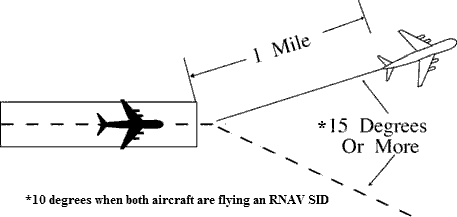
FIG 5-8-2 Simultaneous Departures 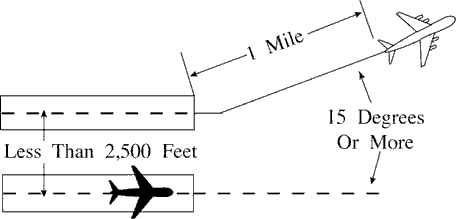
FIG 5-8-3 Simultaneous Departures 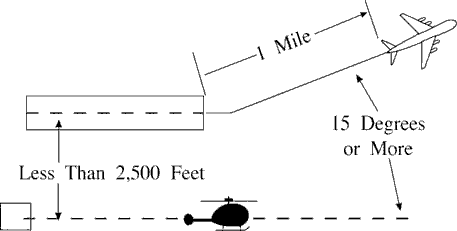
NOTE: This procedure does not apply when wake turbulence separation is required.
- Between simultaneous departures departing in the same direction from parallel runways/helicopter takeoff courses, authorize simultaneous takeoffs if the centerlines/takeoff courses are separated by at least 2,500 feet and courses diverge by 15 degrees or more immediately after departure. (See FIG 5-8-4, and FIG 5-8-5.)
- When both aircraft are flying an RNAV SID:
- Between successive departures from the same runway- 1 mile if courses diverge by 10 degrees or more
immediately after departure. (See FIG 5-8-1.)
NOTE: This procedure does not apply when wake turbulence separation is required.
- Between simultaneous departures from parallel runways/helicopter takeoff courses, authorize simultaneous takeoffs if the centerlines/takeoff courses are separated by at least 700 feet and less than 2,500 feet, courses diverge by 15 degrees or more, and departures are released in accordance with the release distance stagger stated in TBL 5-8-1 below.
-
Between simultaneous departures from parallel runways/helicopter takeoff courses, authorize simultaneous
takeoffs if the centerlines/takeoff courses are separated by at least 2,500 feet and courses diverge by 10
degrees or more immediately after departure. (See FIG 5-8-5, and FIG 5-8-6.)
NOTE: RNAV SIDs specific to this paragraph are those SIDs constructed with a specific lateral path that begins at the DER.
TBL 5-8-1 Departure Release Distances Distance to Divergence (Measured from the further DER) Minimum Centerline Separation Release Distance Stagger Immediately 700 1000 feet No later than 5 NM 1020 2000 feet No later than 8 NM 1130 3000 feet No later than 11 NM 1360 4000 feet NOTE: This procedure does not apply when wake turbulence separation is required.
FIG 5-8-4 Simultaneous Dependent Departures FIG 5-8-5 Parallel Runway Departures 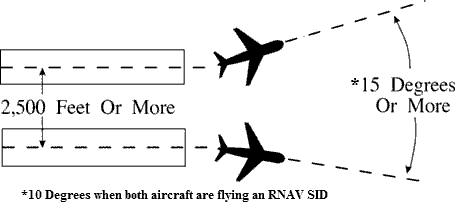
FIG 5-8-5 Parallel Helicopter Course Departures 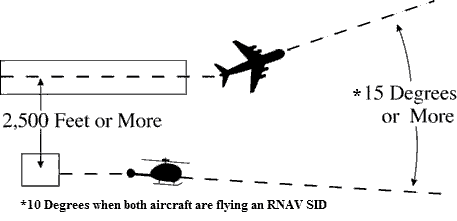
- Between successive departures from the same runway- 1 mile if courses diverge by 10 degrees or more
immediately after departure. (See FIG 5-8-1.)
- Between aircraft departing from diverging runways:
- Nonintersecting runways. Authorize simultaneous takeoffs if runways diverge by 15 degrees or more. (See FIG
5-8-7.)
FIG 5-8-7 Nonintersecting Runway Departures 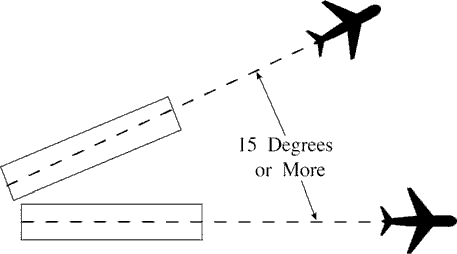
- Intersecting runways and/or helicopter takeoff courses which diverge by 15 degrees or more. Authorize
takeoff of a succeeding aircraft when the preceding aircraft has passed the point of runway and/or takeoff
course intersection. When applicable, apply the procedure in Paragraph 3-9-5, Anticipating Separation. (See
FIG 5-8-8 and FIG 5-8-9.)
FIG 5-8-8 Intersecting Runway Departures 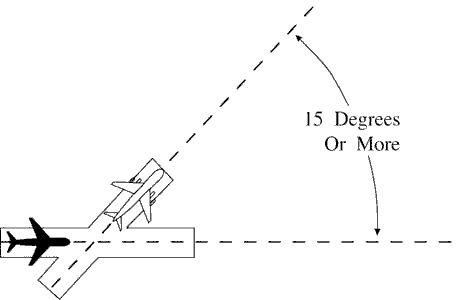
FIG 5-8-9 Intersecting Helicopter Course Departures 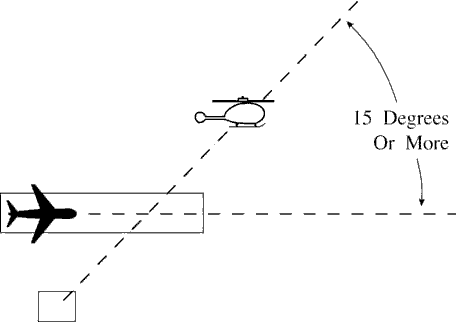
NOTE: This procedure does not apply when wake turbulence separation is required.
- Nonintersecting runways. Authorize simultaneous takeoffs if runways diverge by 15 degrees or more. (See FIG
5-8-7.)
5-8-4. DEPARTURE AND ARRIVAL
TERMINAL.Except as provided in para 5-8-5, Departures and Arrivals on Parallel or Nonintersecting Diverging Runways, separate a departing aircraft from an arriving aircraft on final approach by a minimum of 2 miles if separation will increase to a minimum of 3 miles (5 miles when 40 miles or more from the antenna) within 1 minute after takeoff.
- NOTE:
- 1. This procedure permits a departing aircraft to be released so long as an arriving aircraft is no closer than 2 miles from the runway at the time. This separation is determined at the time the departing aircraft commences takeoff roll.
- 2. Consider the effect surface conditions, such as ice, snow, and other precipitation, may have on known aircraft performance characteristics, and the influence these conditions may have on the pilot's ability to commence takeoff roll in a timely manner.
5-8-5. DEPARTURES AND ARRIVALS ON PARALLEL OR NONINTERSECTING DIVERGING RUNWAYS
TERMINAL. Authorize simultaneous operations between an aircraft departing on a runway and an aircraft on final approach to another parallel or nonintersecting diverging runway if the departure course diverges immediately by at least 30 degrees from the missed approach course until separation is applied and provided one of the following conditions is met:
NOTE: When one or both of the takeoff/landing surfaces is a helipad, consider the helicopter takeoff course as the runway centerline and the helipad center as the threshold.
- When parallel runway thresholds are even, the runway centerlines are at least 2,500 feet apart. (See FIG 5-8-10
and FIG 5-8-11.)
FIG 5-8-10 Parallel Thresholds are Even 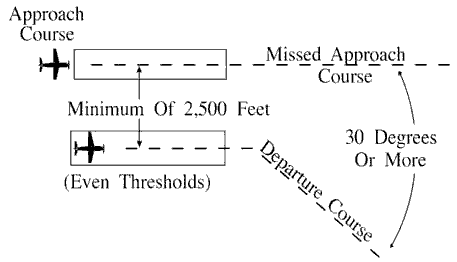
FIG 5-8-11 Parallel Thresholds are Even 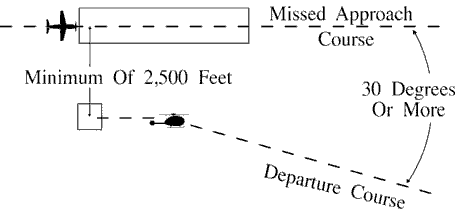
- When parallel runway thresholds are staggered and:
- The arriving aircraft is approaching the nearer runway: the centerlines are at least 1,000 feet apart and
the landing thresholds are staggered at least 500 feet for each 100 feet less than 2,500 the centerlines are
separated. (See FIG 5-8-12 and FIG 5-8-13.)
FIG 5-8-12 Parallel Thresholds are Staggered 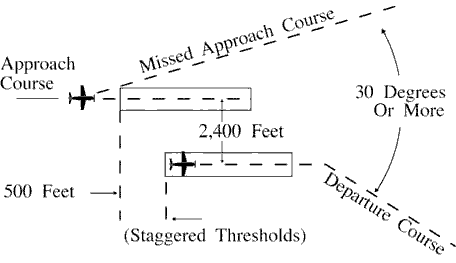
FIG 5-8-13 Parallel Thresholds are Staggered 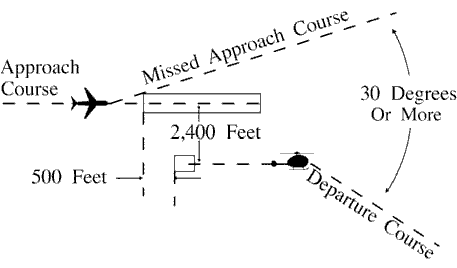
NOTE: In the event of a missed approach by an aircraft requiring wake turbulence separation behind it, apply the procedures in Paragraph 3-9-6, Same Runway Separation and/or Paragraph 3-9-8, Intersecting Runway/Intersecting Flight Path Operations to ensure that the larger aircraft does not overtake or cross in front of an aircraft departing from the adjacent parallel runway.
- The arriving aircraft is approaching the farther runway: the runway centerlines separation exceeds 2,500
feet by at least 100 feet for each 500 feet the landing thresholds are staggered. (See FIG 5-8-14.)
FIG 5-8-14 Parallel Thresholds are Staggered 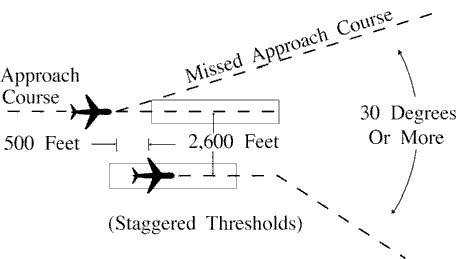
- The arriving aircraft is approaching the nearer runway: the centerlines are at least 1,000 feet apart and
the landing thresholds are staggered at least 500 feet for each 100 feet less than 2,500 the centerlines are
separated. (See FIG 5-8-12 and FIG 5-8-13.)
- When nonintersecting runways diverge by 15 degrees or more and runway edges do not touch. (See FIG 5-8-15.)
FIG 5-8-15 Diverging Nonintersecting Runways 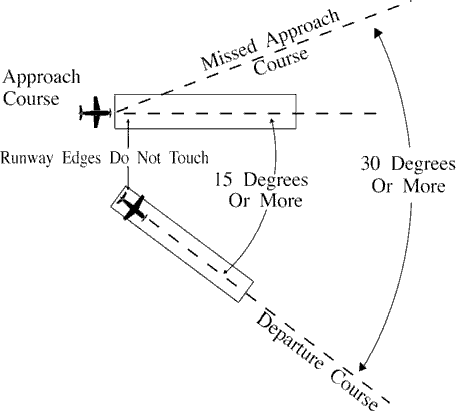
- When the aircraft on takeoff is a helicopter, hold the helicopter until visual separation is possible or apply the separation criteria in subparas a, b, or c.
